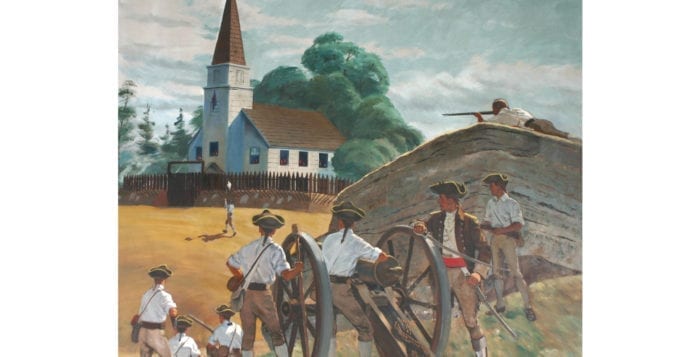By Beverly C. Tyler
Following the Battle of Setauket, Loyalist Lt. Col. Richard Hewlett, who successfully defended the fort at the Presbyterian Church against 150 Continental Army soldiers under the command of Patriot Gen. Samuel Parsons, wrote a letter to New York Royal Gov. Gen. William Tryon. It was received by Tryon in Manhattan Sept. 3, 1777, detailing some of his observations concerning the battle and some of the men of Setauket whom he considered to be “villains … and traitors.”
“Sir, I take the Liberty to give You an Account of the Behaviour of some of the Inhabitants of this County when lately visited by the Rebels, that Your Excellency may have an Idea what kind of Subjects many of them are.
“Our Hospital was at some Distance from the Works — as there was not a convenient House near —When we were attack’d by the Rebels — A Party of them was sent to it — those Sick who were able, attempting to make their Escape — were fir’d at.”
Hewlett specifically named Jonathan Thompson, who was president of the Brookhaven Town Trustees (1769-76), and his son Samuel Thompson, a town commissioner (1773-74), and detailed their actions. The Thompsons lived on North Country Road in Setauket and were both officers in Patriot militias in 1775, before the British took control of Long Island. Their home is today one of most historic homes on Long Island, the Thompson House, located at 91 North Country Road, Setauket, and is now owned by The Ward Melville Heritage Organization.
Hewlett writes, “Jonathan Thompson who lives next to the Hospital, seeing which Way they ran, Call’d out to the Rebels ‘here here they run’ pointing with his Hand the Way they went. Samuel Thompson Son of the above at the same Time endeavour’d to intimidate the Inhabitants — By telling them — Our Fort had surrendered — that the Rebels intended staying two or three Days — and had a twenty Gun Ship and Number of Privateers in the Sound — Stories well calculated to prevent our having Assistance.”
The letter then describes the continuing “rebel” attitudes of many in Setauket, ending with a short report he had neglected to include in his last letter to Tryon.

“Men of this ungenerous Stamp endeavor further by the sly underhand Methods to defraud Government. Their Young Men go over to Connecticut and enter the Rebel Service while their Fathers and Friends take Mortgages on their Estates — and secure in the Oath of Fidelity — hug themselves when they think they have sav’d their Property. There is a constant Correspondence between Connecticut & this County carried on to a most daring Degree I am well convinc’d. The late Party that came over rob’d only me and my Officers Doctr. PUNDERSON & Mr. HUBBARD of our Horses — they must have been particularly pointed out to them as they made great Inquiry after a fine Horse of Captn. ALLISONs on which one of our Men made his Escape that Morning. I neglected mentioning in my late Letter what Equipment the Rebels came over in — it consisted of six Sloops, 26 Whale Boats with other small Craft.”
Hewlett reported what he had discovered about another Setauket resident. This rebel, the husband of Anna Smith Strong and a town trustee from 1767 to 1777 had just recently been replaced on the Brookhaven Town board, along with other Patriot-leaning trustees, by residents loyal to King George III.
“I have this Instant while writing the following authentic Information lodg’d against a Justice Selah Strong by a Gentleman from Connecticut — that he wrote to Genl. Parsons there were a Number of Vessels collecting Forage at Southold — Guarded by a fourteen Gun Schooner and fifty Men on Shore under the Command of Captn. Raymond — who might easily be surpris’d.
“That he secreted a Deserter three Weeks who went by the Name of BOYD — that he has repeatedly sent Intelligence to the Rebels in Connecticut of the Situation of the Troops in this Place by John and Cornelius Clark. This very Mr. Strong has pretended to be our Friend — and several Times given Information of the last nam’d Persons being over — but not untill they were gone. What Security can Government receive — while there are such Villains ready to stab her in secret.
“That Success may attend your Excellency’s Arms and all Traitors be discover’d is the sincere Wish of — Your most oblig’d humble Servt. Richard HEWLETT L.C.”
Hewlett’s letter, in the University of Michigan, William L. Clements Library, Sir Henry Clinton Papers, helps confirm Selah Strong’s activity as a spy for Gen. Washington a full year before the Culper Spy Ring began operations under Abraham Woodhull. It also ties in directly to the efforts of Benjamin Tallmadge, at the time second in command to intelligence chief Gen. Charles Scott, and to Caleb Brewster, who by this time was already carrying spy messages from Washington spy John Clark across Long Island Sound to Fairfield, Connecticut, and through Tallmadge to Washington’s headquarters. The Hewlett letter also became one of the factors that led to Strong’s arrest and imprisonment in New York City as reported by the Jan. 3, 1778, issue of Rivington’s Royalist Gazette.
Beverly C. Tyler is Three Village Historical Society historian and author of books available from the society at 93 North Country Road, Setauket. For more information, call 631-751-3730 or visit www.tvhs.org.






